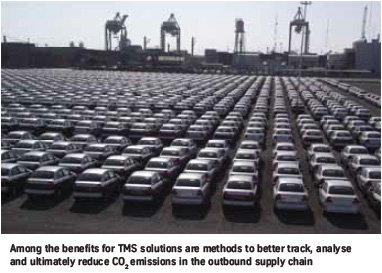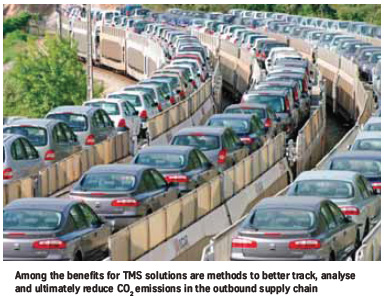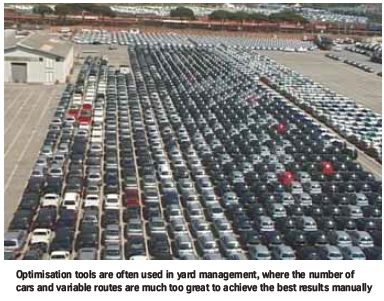The use of IT tools to improve efficiency in the outbound supply chain is increasing, but the question is how far providers and OEMs are willing to go. Andrew Williams investigates the potential for systems across networks and nations.
IT optimisation software can offer a great deal to carmakers and vehicle logistics providers: its ability to process and determine thousands of options simultaneously can reduce mileage, improve load factors and lower CO2 emissions. But such software is not a panacea for human management and close coordination in the supply chain. Indeed, the effectiveness of such systems depends not only on the software providers that programme the systems but on the willingness among carmakers and logistics providers to engage and share information about the network, its pipeline and in real time. Some specialists on the market are even looking to take their solutions to the next level by engaging multiple carmakers or even an entire market onto the same network system.
Strategic, tactical and operational
Such software can be divided between strategic, tactical and operational optimisation tools. Strategic tools deal with the network itself, including the location of manufacturing plants, compounds, distribution centres, warehouses, dealers and customers and decisions that affect how efficiently the network operates, according to Dominic Regan, senior director of transportation management at Oracle.
 Tactical optimisation takes the pre-defined network as the starting point and analyses factors that influence its operational efficiency, including how to combine different supply chains to increase asset utilisation and work out the optimal combination of in-house versus third-party transport. Finally, operational optimisation tools consider real demand and supply signals and determine how to execute them from a transport perspective in the most cost-effective way. “These decisions address such challenges as ‘which mode or carrier should I use to get this car from plant to dealer?’ or ‘how can I consolidate orders or link shipments to increase utilisation?’” says Regan.
Tactical optimisation takes the pre-defined network as the starting point and analyses factors that influence its operational efficiency, including how to combine different supply chains to increase asset utilisation and work out the optimal combination of in-house versus third-party transport. Finally, operational optimisation tools consider real demand and supply signals and determine how to execute them from a transport perspective in the most cost-effective way. “These decisions address such challenges as ‘which mode or carrier should I use to get this car from plant to dealer?’ or ‘how can I consolidate orders or link shipments to increase utilisation?’” says Regan.
Steve Jones, managing director at Vehnet, argues that there is a difference between ‘optimisation’ and ‘decision-support.’ He explains that optimisation is performed by applying mathematical techniques that produce the ‘best’ solution to any given problem. By its nature, the process is automated, requiring the user to select some parameters and initiate the process. The data then delivered to managers should enhance their ability to visualise the situation and to act. “In this case, the human computer–we call it the ‘the necktop computer’–is assisted by the IT system, but makes the final decisions. In reality of course, the two approaches co-exist and in our view they must co-exist,” he says. “Optimisation is incredibly valuable but human skill and judgement is still required.”
Collaborative approach?
An important question is whether these tools are best used to optimise networks for carmakers individually, or if they can be combined with other systems to get better results across the entire sector? Regan explains that this approach is gaining traction in other industries, noticeably consumer goods. Companies that have optimised their own supply chains recognise that the next step-change in benefits can only be realised by taking a cross-enterprise view. Regan believes that true collaboration will require the emergence of suitably qualified third parties who can objectively analyse a variety of supply chains. For him, the obvious candidates to do this would be the third party logistics providers, yet he believes they take too much of an account-centric approach that precludes this type of objectivity.
“I would love to be proved wrong, but when was the last time an LSP challenged a customer to re-structure its supply chain such that it would result in lower spending with the LSP? This is where asset-neutral lead logistics providers and 4PLs are gaining traction, but also the emergence of so-called ‘supply chain orchestrators’,” he says. “What all of these require are software solutions that provide suitable optimisation and analytical capabilities in terms of evaluating potentially collaborative supply chains, as well as transparency to the end-customer of the decisionmaking process when selecting the appropriate mode, carrier and service level,” he adds.
Meanwhile Mike Thorby, director at Car Delivery Network, believes that the industry tends to be too cost-focused on individual logistics plans. “The easiest solution is for every carmaker and carrier to strive to optimise their logistics plan, however to truly optimise they all need to work together as a network,” he says.
Vehnet’s Jones goes so far as to say that the days of one carmaker optimising its own network will soon be over. In his opinion, beating rates down further is no longer possible. “Evidence shows that carrier margins could not be thinner and the opportunity for further reductions is virtually nil,” he says. “The real breakthrough will come when carmakers and carriers visualise the problem across the entire network. For this to happen they need to provide information for analysis and to exchange information on a daily operational basis. The big issue to overcome is that of trust,” he adds.
In the USA, Vehnet has initiated the NENA Project (Network Efficiency North America), which aims to provide a neutral  forum for information analysis and exchange. In the early stages this will be a decision-support mechanism that presents performance ‘hot spots’ in map and graphic form so that carriers and carmakers can work on solutions.
forum for information analysis and exchange. In the early stages this will be a decision-support mechanism that presents performance ‘hot spots’ in map and graphic form so that carriers and carmakers can work on solutions.
Also on a practical level, Matthias Berlit, vice president of manufacturing logistics at Inform, explains that the greater ‘mass’ such joint operations attain, the more opportunities for optimisation are involved. Inform is currently in discussions with other partners to provide them with more data for a collaborative approach in the UK. “We hope to have the results of this study at the beginning of 2012. Anybody interested in cooperating is welcome to join,” he adds.
Jones believes there is a clear path to making such collaboration work. “[In terms of how] this can work in practice, I think the carriers could build alliances in which they cooperate. Then they put all their orders in a ‘joint-order pot’ and let the optimiser build the loads. The TMS then assigns the loads to the best available trucks, assuring a fair share between the participants,” he says.
Rolling out the system network wide
Some observers have highlighted the need for an industry wide ‘optimisation model’ tool that would help identify return loads and promote better routing, perhaps using software that would be applicable and open to the entire industry at a national or international level–at little or no cost. Indeed, at the recent Automotive Logistics Global conference, the chairman of Jack Cooper, a large car carrier, hinted that his company was interested in developing such a platform.
Oracle’s Regan would endorse the idea of investigating cross-supply chain efficiencies for vehicle logistics. However, he is keen to stress the danger that the resulting operation would be operated at the ‘lowest common denominator,’ and emphasises how important it is that individual supply chains continue to be scrutinised to increase efficiency.
His view is that, although such an industry-wide optimisation model would be very attractive, the practicality of such a solution is questionable unless a robust method can be determined for ensuring transparency in all decisions, as well as allocating the resulting cost savings among the carmaker, logistics provider and software solution provider. “[However], talking from the perspective of a software vendor, I doubt it would be a surprise to find me questioning how such a model would work on a ‘no-cost’ basis. There are some key challenges that would need to be addressed,” he says. These challenges would include the need to establish what the incentive was for such a solution to be developed in the first place, as well as how the costs of hosting, support and ongoing development would be met.
 “Who would be responsible for the integration of such a solution with the legacy systems that are to be found within the industry, and how would this integration be funded? If these type of questions aren’t addressed, I would think it could prove challenging to find companies to sign up given the risk inherent in such a model,” Regan continues. Jones maintains that there is no such thing as ‘no cost’ but that solutions that yield a heavy return on investment should be possible, given the large amount of wasted capacity in the transport network. For him, the issue is not really one of technology, but rather the trust that must be established to share information.
“Who would be responsible for the integration of such a solution with the legacy systems that are to be found within the industry, and how would this integration be funded? If these type of questions aren’t addressed, I would think it could prove challenging to find companies to sign up given the risk inherent in such a model,” Regan continues. Jones maintains that there is no such thing as ‘no cost’ but that solutions that yield a heavy return on investment should be possible, given the large amount of wasted capacity in the transport network. For him, the issue is not really one of technology, but rather the trust that must be established to share information.
“From personal experience in Europe and the USA this is the barrier. While there are dozens of worthy solutions out there for load sharing, each claiming to be unique, the very fact that the take-up of each system is localised to a few carriers means that the vital overview of the entire network can never be achieved,” he says.
Questions certainly remain about how such a system would work in the competitive marketplace, particularly as the system would upend the commercial relationships that companies have sought to build so strongly. While efficiency is a nice word, few are likely to accept that adding it to the supply chain means their companies lose a majority of their business to other providers. Regardless of these larger questions, it looks as though IT optimisation tools will assume a position of more importance in vehicle logistics planning. There also appears to be a interest in an industry-wide optimisation model–but the details of how such an approach might work in practice remain very much open to debate.



































